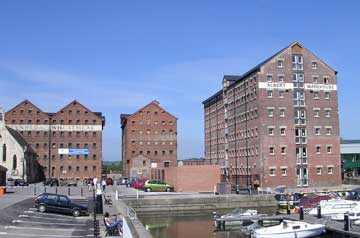Gloucester
Docks & |
|
Gloucester Warehouses & Mills |
Location Map North
Warehouse Lock
& Pillar Warehouses Albert
Britannia & Victoria Warehouses Warehouses |
|
|
The old warehouses, here viewed from the lock, were built with thick brick walls, a slate roof and strong wooden floors supported by cast-iron columns. The many small windows were intended more for ventilation than for light and were originally fitted with shutters rather than glass. The corn was stored in sacks that were lifted up to the required floor by manually operated winches in the loft. The location and building dates of individual warehouses and mills are noted below. (Photo: A.Done) |
Following the decline in the number of sea-going ships coming to Gloucester, there was less need for corn storage, and in the twentieth century many of the warehouses were occupied by businesses such as builders' merchants who had no connection with water transport. Although even these uses declined, most of the warehouses survived and are now vital features in the redevelopment of the area. The new green building is the Merchants Quay shopping centre. |
|
|
|
The Albert Warehouse was converted to a flour mill by J. Reynolds & Co. in 1869, with the addition of a boiler house etc to the south. As the business expanded, Double Reynolds and Vining's Warehouses (almost hidden in the background) were used for flour and wheat storage. (Photo Glos. Collection) |
The mill closed in 1977 and the ancilliary buildings were demolished. After housing the Robert Opie Collection of Packaging for several years, Albert Warehouse was converted to apartments in 2003, and Double Reynolds and Vining's Warehouses followed. |



